University of Surrey: Innovation Management Report on Diageo (MANM115)
VerifiedAdded on 2021/05/31
|19
|5715
|290
Report
AI Summary
This report provides a comprehensive analysis of Diageo PLC's innovation management, examining its organizational structure, strategies, and the external environment in which it operates. The report begins with an introduction to Diageo and the alcoholic beverage industry, followed by an analysis of the competitive landscape using Porter's Five Forces. It then delves into Diageo's organizational structure, leadership, and corporate culture, highlighting how these elements contribute to its innovation efforts. The report further explores Diageo's innovation strategy, including its innovation process, search strategies, supply chain, and mapping of its innovation space. Based on this analysis, the report offers recommendations for improving Diageo's innovation process, focusing on exploit strategies and reframing. The report concludes with a summary of the key findings and recommendations. The report is supported by references and an appendix detailing Diageo's stakeholder communication.
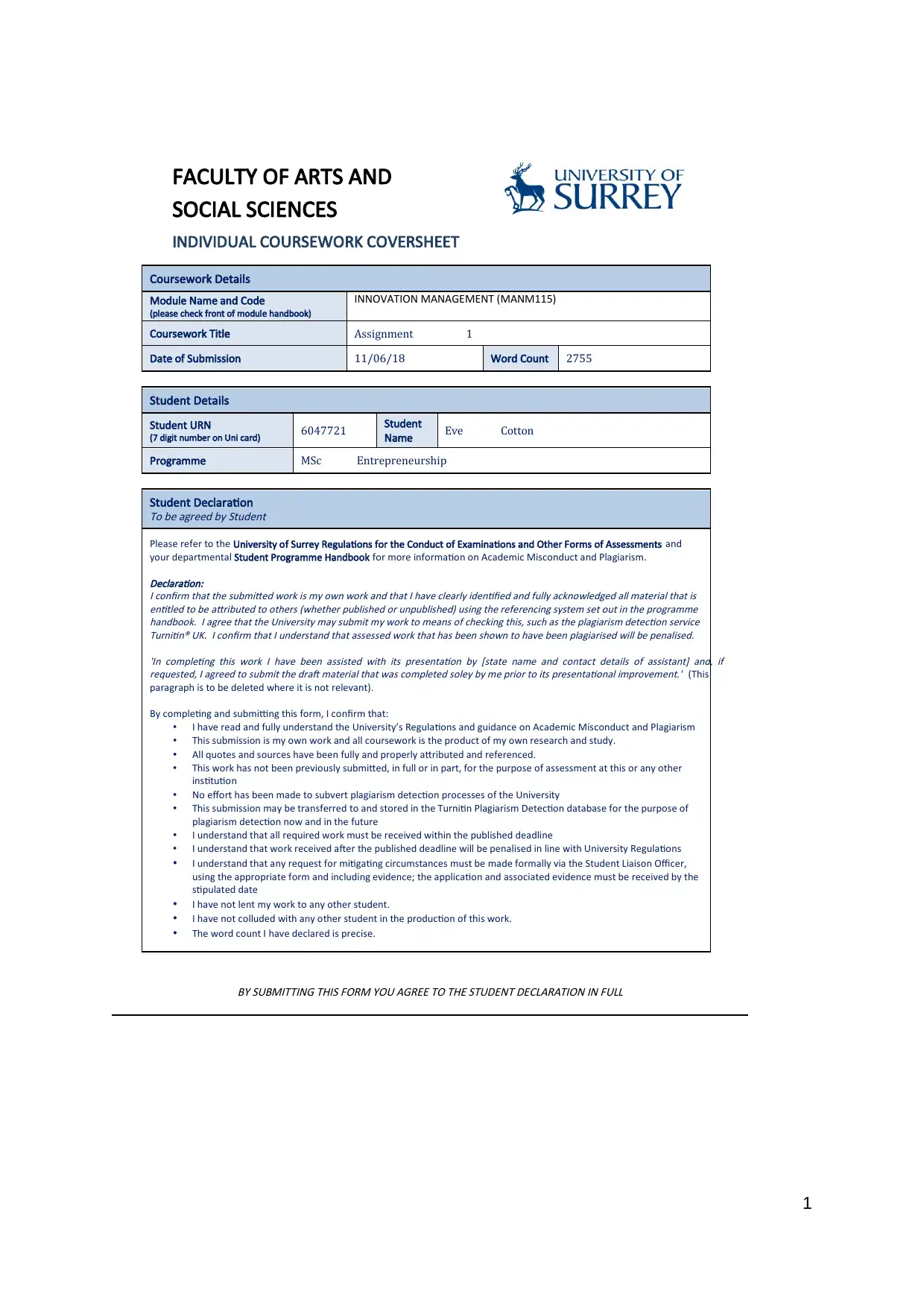
1
BY SUBMITTING THIS FORM YOU AGREE TO THE STUDENT DECLARATION IN FULL
FACULTY OF ARTS AND
SOCIAL SCIENCES
INDIVIDUAL COURSEWORK COVERSHEET
Coursework Details
Module Name and Code
(please check front of module handbook)
INNOVATION MANAGEMENT (MANM115)
Coursework Title Assignment 1
Date of Submission 11/06/18 Word Count 2755
Student Details
Student URN
(7 digit number on Uni card) 6047721 Student
Name Eve Cotton
Programme MSc Entrepreneurship
Student Declaration
To be agreed by Student
Please refer to the University of Surrey Regulations for the Conduct of Examinations and Other Forms of Assessments and
your departmental Student Programme Handbook for more information on Academic Misconduct and Plagiarism.
Declaration:
I confirm that the submitted work is my own work and that I have clearly identified and fully acknowledged all material that is
entitled to be attributed to others (whether published or unpublished) using the referencing system set out in the programme
handbook. I agree that the University may submit my work to means of checking this, such as the plagiarism detection service
Turnitin® UK. I confirm that I understand that assessed work that has been shown to have been plagiarised will be penalised.
'In completing this work I have been assisted with its presentation by [state name and contact details of assistant] and, if
requested, I agreed to submit the draft material that was completed soley by me prior to its presentational improvement.' (This
paragraph is to be deleted where it is not relevant).
By completing and submitting this form, I confirm that:
• I have read and fully understand the University’s Regulations and guidance on Academic Misconduct and Plagiarism
• This submission is my own work and all coursework is the product of my own research and study.
• All quotes and sources have been fully and properly attributed and referenced.
• This work has not been previously submitted, in full or in part, for the purpose of assessment at this or any other
institution
• No effort has been made to subvert plagiarism detection processes of the University
• This submission may be transferred to and stored in the Turnitin Plagiarism Detection database for the purpose of
plagiarism detection now and in the future
• I understand that all required work must be received within the published deadline
• I understand that work received after the published deadline will be penalised in line with University Regulations
• I understand that any request for mitigating circumstances must be made formally via the Student Liaison Officer,
using the appropriate form and including evidence; the application and associated evidence must be received by the
stipulated date
• I have not lent my work to any other student.
• I have not colluded with any other student in the production of this work.
• The word count I have declared is precise.
BY SUBMITTING THIS FORM YOU AGREE TO THE STUDENT DECLARATION IN FULL
FACULTY OF ARTS AND
SOCIAL SCIENCES
INDIVIDUAL COURSEWORK COVERSHEET
Coursework Details
Module Name and Code
(please check front of module handbook)
INNOVATION MANAGEMENT (MANM115)
Coursework Title Assignment 1
Date of Submission 11/06/18 Word Count 2755
Student Details
Student URN
(7 digit number on Uni card) 6047721 Student
Name Eve Cotton
Programme MSc Entrepreneurship
Student Declaration
To be agreed by Student
Please refer to the University of Surrey Regulations for the Conduct of Examinations and Other Forms of Assessments and
your departmental Student Programme Handbook for more information on Academic Misconduct and Plagiarism.
Declaration:
I confirm that the submitted work is my own work and that I have clearly identified and fully acknowledged all material that is
entitled to be attributed to others (whether published or unpublished) using the referencing system set out in the programme
handbook. I agree that the University may submit my work to means of checking this, such as the plagiarism detection service
Turnitin® UK. I confirm that I understand that assessed work that has been shown to have been plagiarised will be penalised.
'In completing this work I have been assisted with its presentation by [state name and contact details of assistant] and, if
requested, I agreed to submit the draft material that was completed soley by me prior to its presentational improvement.' (This
paragraph is to be deleted where it is not relevant).
By completing and submitting this form, I confirm that:
• I have read and fully understand the University’s Regulations and guidance on Academic Misconduct and Plagiarism
• This submission is my own work and all coursework is the product of my own research and study.
• All quotes and sources have been fully and properly attributed and referenced.
• This work has not been previously submitted, in full or in part, for the purpose of assessment at this or any other
institution
• No effort has been made to subvert plagiarism detection processes of the University
• This submission may be transferred to and stored in the Turnitin Plagiarism Detection database for the purpose of
plagiarism detection now and in the future
• I understand that all required work must be received within the published deadline
• I understand that work received after the published deadline will be penalised in line with University Regulations
• I understand that any request for mitigating circumstances must be made formally via the Student Liaison Officer,
using the appropriate form and including evidence; the application and associated evidence must be received by the
stipulated date
• I have not lent my work to any other student.
• I have not colluded with any other student in the production of this work.
• The word count I have declared is precise.
Paraphrase This Document
Need a fresh take? Get an instant paraphrase of this document with our AI Paraphraser

2
TABLE OF CONTENT
EXECUTIVE SUMMARY 3
MAIN BODY 4
1 INTRODUCTION 4
2 EXTERNAL ENVIRONMENT 4
3 ORGANISATION FOR INNOVATION MANAGEMENT 6
3.1 DIAGEO STRUCTURE 6
3.2 DIAGEO LEADERSHIP 7
3.3 DIAGEO CULTURE 7
3.4 KNOWLEDGE MANAGEMENT 9
4 STRATEGY FOR INNOVATION MANAGEMENT 9
4.1 INNOVATION PROCESS 9
4.2 SEARCH STRATEGIES 10
4.3 DIAGEO SUPPLY CHAIN 12
4.4 MAPPING DIAGEO INNOVATION SPACE 13
5 RECOMMENDATIONS ON INNOVATION PROCESS 15
5.1 EXPLOIT STRATEGIES 15
5.2 REFRAMING 15
6 CONCLUSIONS 16
REFERENCES 17
APPENDIX A - DIAGEO STAKEHOLDER COMMUNICATION 19
TABLE OF CONTENT
EXECUTIVE SUMMARY 3
MAIN BODY 4
1 INTRODUCTION 4
2 EXTERNAL ENVIRONMENT 4
3 ORGANISATION FOR INNOVATION MANAGEMENT 6
3.1 DIAGEO STRUCTURE 6
3.2 DIAGEO LEADERSHIP 7
3.3 DIAGEO CULTURE 7
3.4 KNOWLEDGE MANAGEMENT 9
4 STRATEGY FOR INNOVATION MANAGEMENT 9
4.1 INNOVATION PROCESS 9
4.2 SEARCH STRATEGIES 10
4.3 DIAGEO SUPPLY CHAIN 12
4.4 MAPPING DIAGEO INNOVATION SPACE 13
5 RECOMMENDATIONS ON INNOVATION PROCESS 15
5.1 EXPLOIT STRATEGIES 15
5.2 REFRAMING 15
6 CONCLUSIONS 16
REFERENCES 17
APPENDIX A - DIAGEO STAKEHOLDER COMMUNICATION 19
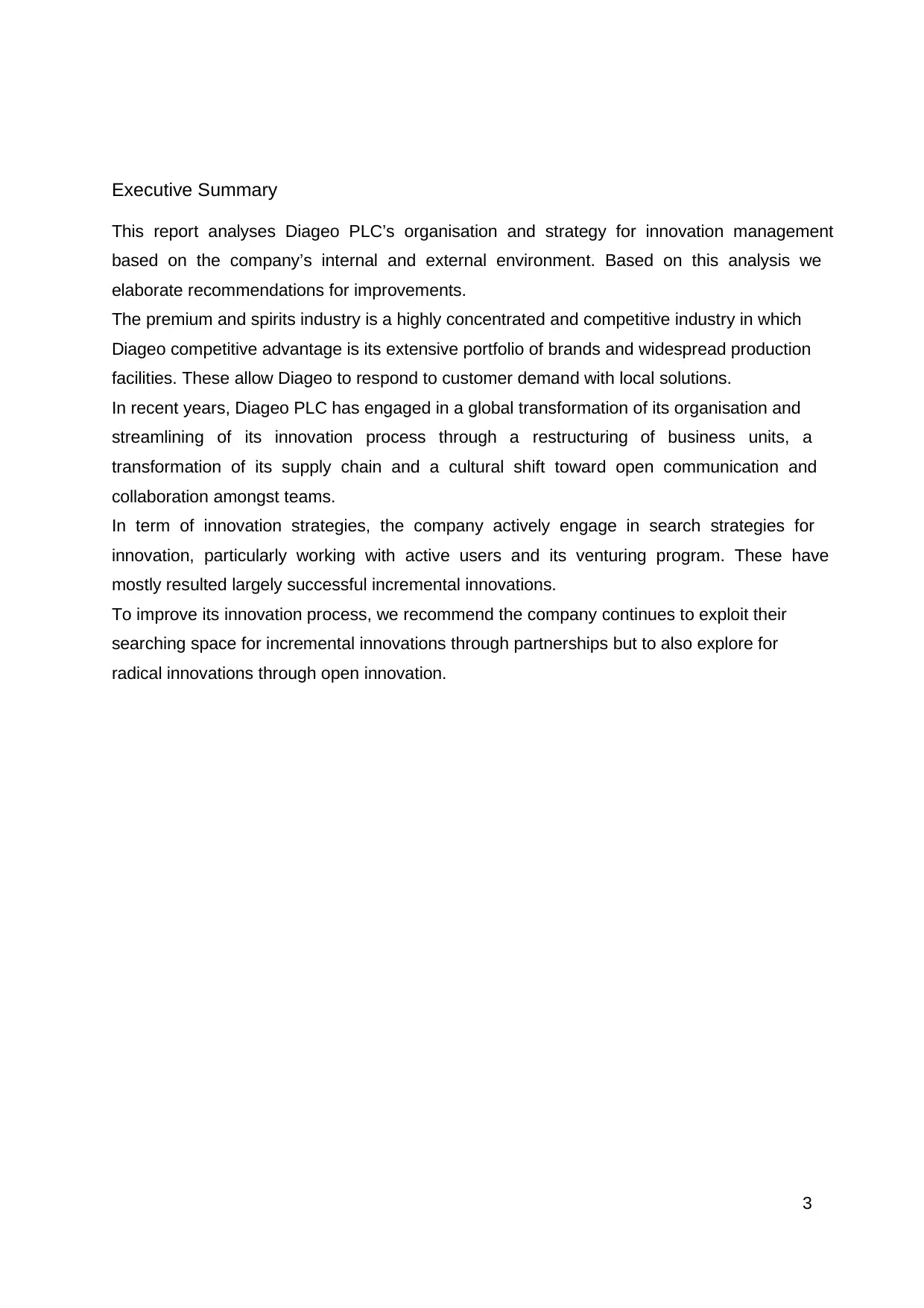
3
Executive Summary
This report analyses Diageo PLC’s organisation and strategy for innovation management
based on the company’s internal and external environment. Based on this analysis we
elaborate recommendations for improvements.
The premium and spirits industry is a highly concentrated and competitive industry in which
Diageo competitive advantage is its extensive portfolio of brands and widespread production
facilities. These allow Diageo to respond to customer demand with local solutions.
In recent years, Diageo PLC has engaged in a global transformation of its organisation and
streamlining of its innovation process through a restructuring of business units, a
transformation of its supply chain and a cultural shift toward open communication and
collaboration amongst teams.
In term of innovation strategies, the company actively engage in search strategies for
innovation, particularly working with active users and its venturing program. These have
mostly resulted largely successful incremental innovations.
To improve its innovation process, we recommend the company continues to exploit their
searching space for incremental innovations through partnerships but to also explore for
radical innovations through open innovation.
Executive Summary
This report analyses Diageo PLC’s organisation and strategy for innovation management
based on the company’s internal and external environment. Based on this analysis we
elaborate recommendations for improvements.
The premium and spirits industry is a highly concentrated and competitive industry in which
Diageo competitive advantage is its extensive portfolio of brands and widespread production
facilities. These allow Diageo to respond to customer demand with local solutions.
In recent years, Diageo PLC has engaged in a global transformation of its organisation and
streamlining of its innovation process through a restructuring of business units, a
transformation of its supply chain and a cultural shift toward open communication and
collaboration amongst teams.
In term of innovation strategies, the company actively engage in search strategies for
innovation, particularly working with active users and its venturing program. These have
mostly resulted largely successful incremental innovations.
To improve its innovation process, we recommend the company continues to exploit their
searching space for incremental innovations through partnerships but to also explore for
radical innovations through open innovation.
⊘ This is a preview!⊘
Do you want full access?
Subscribe today to unlock all pages.

Trusted by 1+ million students worldwide
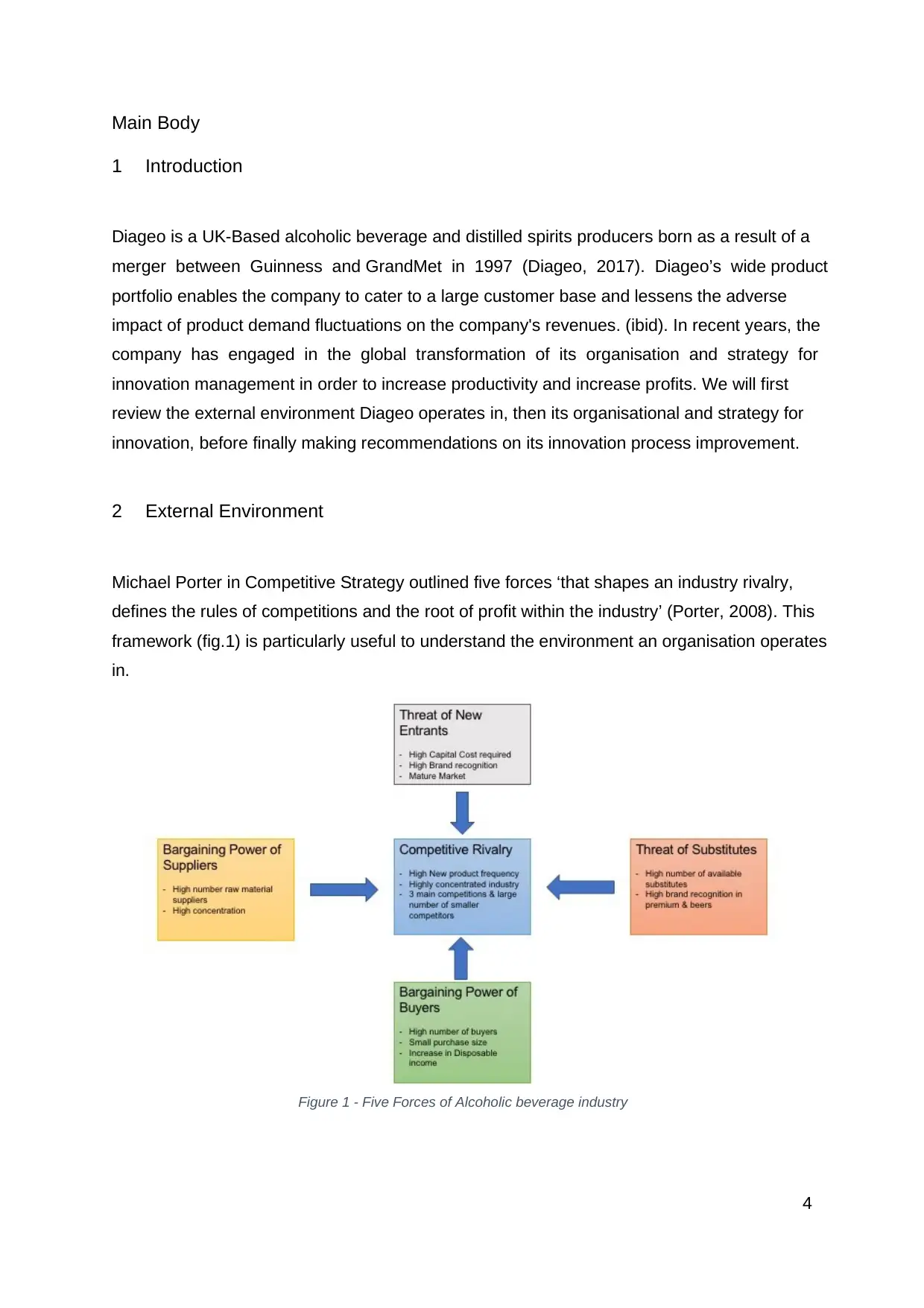
4
Main Body
1 Introduction
Diageo is a UK-Based alcoholic beverage and distilled spirits producers born as a result of a
merger between Guinness and GrandMet in 1997 (Diageo, 2017). Diageo’s wide product
portfolio enables the company to cater to a large customer base and lessens the adverse
impact of product demand fluctuations on the company's revenues. (ibid). In recent years, the
company has engaged in the global transformation of its organisation and strategy for
innovation management in order to increase productivity and increase profits. We will first
review the external environment Diageo operates in, then its organisational and strategy for
innovation, before finally making recommendations on its innovation process improvement.
2 External Environment
Michael Porter in Competitive Strategy outlined five forces ‘that shapes an industry rivalry,
defines the rules of competitions and the root of profit within the industry’ (Porter, 2008). This
framework (fig.1) is particularly useful to understand the environment an organisation operates
in.
Figure 1 - Five Forces of Alcoholic beverage industry
Main Body
1 Introduction
Diageo is a UK-Based alcoholic beverage and distilled spirits producers born as a result of a
merger between Guinness and GrandMet in 1997 (Diageo, 2017). Diageo’s wide product
portfolio enables the company to cater to a large customer base and lessens the adverse
impact of product demand fluctuations on the company's revenues. (ibid). In recent years, the
company has engaged in the global transformation of its organisation and strategy for
innovation management in order to increase productivity and increase profits. We will first
review the external environment Diageo operates in, then its organisational and strategy for
innovation, before finally making recommendations on its innovation process improvement.
2 External Environment
Michael Porter in Competitive Strategy outlined five forces ‘that shapes an industry rivalry,
defines the rules of competitions and the root of profit within the industry’ (Porter, 2008). This
framework (fig.1) is particularly useful to understand the environment an organisation operates
in.
Figure 1 - Five Forces of Alcoholic beverage industry
Paraphrase This Document
Need a fresh take? Get an instant paraphrase of this document with our AI Paraphraser
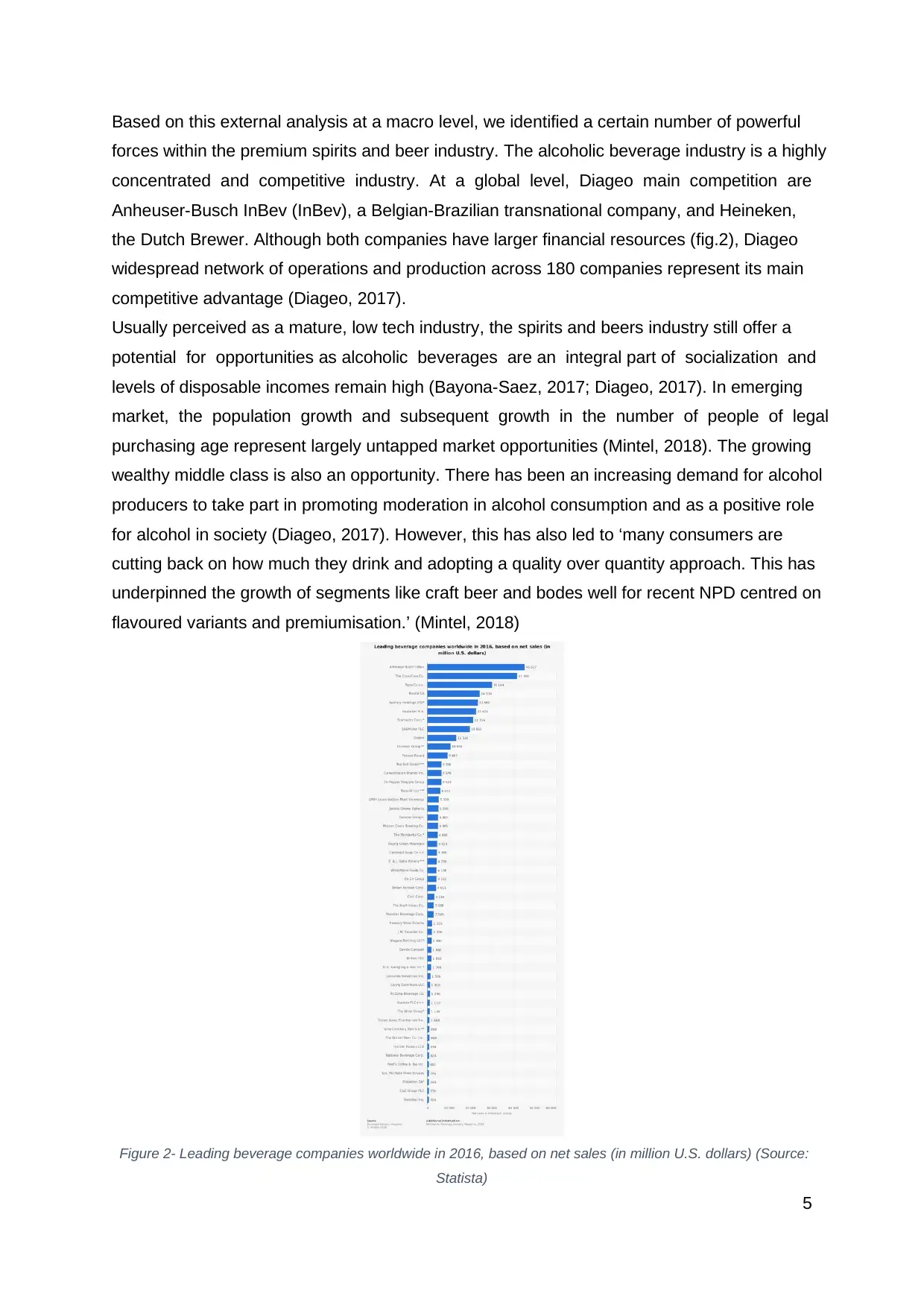
5
Based on this external analysis at a macro level, we identified a certain number of powerful
forces within the premium spirits and beer industry. The alcoholic beverage industry is a highly
concentrated and competitive industry. At a global level, Diageo main competition are
Anheuser-Busch InBev (InBev), a Belgian-Brazilian transnational company, and Heineken,
the Dutch Brewer. Although both companies have larger financial resources (fig.2), Diageo
widespread network of operations and production across 180 companies represent its main
competitive advantage (Diageo, 2017).
Usually perceived as a mature, low tech industry, the spirits and beers industry still offer a
potential for opportunities as alcoholic beverages are an integral part of socialization and
levels of disposable incomes remain high (Bayona-Saez, 2017; Diageo, 2017). In emerging
market, the population growth and subsequent growth in the number of people of legal
purchasing age represent largely untapped market opportunities (Mintel, 2018). The growing
wealthy middle class is also an opportunity. There has been an increasing demand for alcohol
producers to take part in promoting moderation in alcohol consumption and as a positive role
for alcohol in society (Diageo, 2017). However, this has also led to ‘many consumers are
cutting back on how much they drink and adopting a quality over quantity approach. This has
underpinned the growth of segments like craft beer and bodes well for recent NPD centred on
flavoured variants and premiumisation.’ (Mintel, 2018)
Figure 2- Leading beverage companies worldwide in 2016, based on net sales (in million U.S. dollars) (Source:
Statista)
Based on this external analysis at a macro level, we identified a certain number of powerful
forces within the premium spirits and beer industry. The alcoholic beverage industry is a highly
concentrated and competitive industry. At a global level, Diageo main competition are
Anheuser-Busch InBev (InBev), a Belgian-Brazilian transnational company, and Heineken,
the Dutch Brewer. Although both companies have larger financial resources (fig.2), Diageo
widespread network of operations and production across 180 companies represent its main
competitive advantage (Diageo, 2017).
Usually perceived as a mature, low tech industry, the spirits and beers industry still offer a
potential for opportunities as alcoholic beverages are an integral part of socialization and
levels of disposable incomes remain high (Bayona-Saez, 2017; Diageo, 2017). In emerging
market, the population growth and subsequent growth in the number of people of legal
purchasing age represent largely untapped market opportunities (Mintel, 2018). The growing
wealthy middle class is also an opportunity. There has been an increasing demand for alcohol
producers to take part in promoting moderation in alcohol consumption and as a positive role
for alcohol in society (Diageo, 2017). However, this has also led to ‘many consumers are
cutting back on how much they drink and adopting a quality over quantity approach. This has
underpinned the growth of segments like craft beer and bodes well for recent NPD centred on
flavoured variants and premiumisation.’ (Mintel, 2018)
Figure 2- Leading beverage companies worldwide in 2016, based on net sales (in million U.S. dollars) (Source:
Statista)
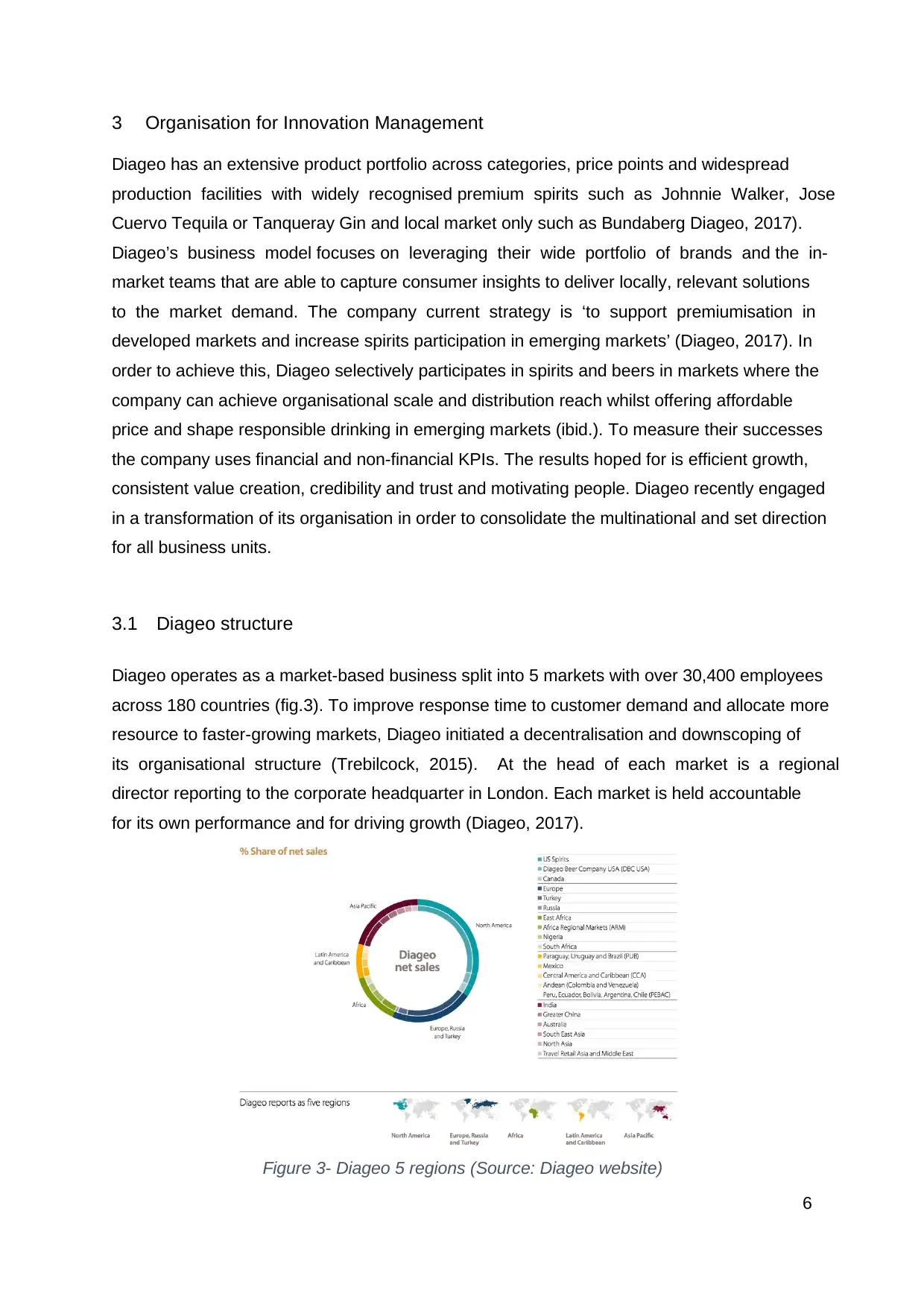
6
3 Organisation for Innovation Management
Diageo has an extensive product portfolio across categories, price points and widespread
production facilities with widely recognised premium spirits such as Johnnie Walker, Jose
Cuervo Tequila or Tanqueray Gin and local market only such as Bundaberg Diageo, 2017).
Diageo’s business model focuses on leveraging their wide portfolio of brands and the in-
market teams that are able to capture consumer insights to deliver locally, relevant solutions
to the market demand. The company current strategy is ‘to support premiumisation in
developed markets and increase spirits participation in emerging markets’ (Diageo, 2017). In
order to achieve this, Diageo selectively participates in spirits and beers in markets where the
company can achieve organisational scale and distribution reach whilst offering affordable
price and shape responsible drinking in emerging markets (ibid.). To measure their successes
the company uses financial and non-financial KPIs. The results hoped for is efficient growth,
consistent value creation, credibility and trust and motivating people. Diageo recently engaged
in a transformation of its organisation in order to consolidate the multinational and set direction
for all business units.
3.1 Diageo structure
Diageo operates as a market-based business split into 5 markets with over 30,400 employees
across 180 countries (fig.3). To improve response time to customer demand and allocate more
resource to faster-growing markets, Diageo initiated a decentralisation and downscoping of
its organisational structure (Trebilcock, 2015). At the head of each market is a regional
director reporting to the corporate headquarter in London. Each market is held accountable
for its own performance and for driving growth (Diageo, 2017).
Figure 3- Diageo 5 regions (Source: Diageo website)
3 Organisation for Innovation Management
Diageo has an extensive product portfolio across categories, price points and widespread
production facilities with widely recognised premium spirits such as Johnnie Walker, Jose
Cuervo Tequila or Tanqueray Gin and local market only such as Bundaberg Diageo, 2017).
Diageo’s business model focuses on leveraging their wide portfolio of brands and the in-
market teams that are able to capture consumer insights to deliver locally, relevant solutions
to the market demand. The company current strategy is ‘to support premiumisation in
developed markets and increase spirits participation in emerging markets’ (Diageo, 2017). In
order to achieve this, Diageo selectively participates in spirits and beers in markets where the
company can achieve organisational scale and distribution reach whilst offering affordable
price and shape responsible drinking in emerging markets (ibid.). To measure their successes
the company uses financial and non-financial KPIs. The results hoped for is efficient growth,
consistent value creation, credibility and trust and motivating people. Diageo recently engaged
in a transformation of its organisation in order to consolidate the multinational and set direction
for all business units.
3.1 Diageo structure
Diageo operates as a market-based business split into 5 markets with over 30,400 employees
across 180 countries (fig.3). To improve response time to customer demand and allocate more
resource to faster-growing markets, Diageo initiated a decentralisation and downscoping of
its organisational structure (Trebilcock, 2015). At the head of each market is a regional
director reporting to the corporate headquarter in London. Each market is held accountable
for its own performance and for driving growth (Diageo, 2017).
Figure 3- Diageo 5 regions (Source: Diageo website)
⊘ This is a preview!⊘
Do you want full access?
Subscribe today to unlock all pages.

Trusted by 1+ million students worldwide

7
Each market is then divided into individual different units, giving more autonomy to units in
each of these markets to respond to local demand and work different projects (Lucas, 2011).
Although, the organisation has relatively centralized power and hierarchical structure with a
narrow scope of control at the top, its bottom organisational structure is to some extent
entrepreneurial, fostering collaboration amongst the team to promote innovation. This hybrid
organisational structure allows for agility and faster response time to customer demand
(Zegler, 2010).
Diageo’s innovation team, the liquid innovation team, spans across marketing and product
development which enables them to be involved with the development function. For example,
during the development of Rokk’s vodka, the technical team brought freeze filtration to the
development table as new technology/crafting processes available to the company. Cross-
functional teams allow Diageo to foster collaborations and emergence of innovative ideas
(Zegler, 2010).
3.2 Diageo leadership
Current CEO of Diageo Ivan Menezes was appointed in July 2013 after having held multiple
positions within the company since 1997. Prior to Diageo, he held positions in Marketing and
Strategy roles at Nestle, Booz Allen Hamilton Inc. and Whirlpool (Diageo, 2017). Leadership
is concerned with setting direction, communicating and motivating and stem from authority
and expertise (Burns, 2013). Leadership and Entrepreneurial literature varies in term of traits
to be an effective leader but agree that it requires emotional intelligence, self-awareness, and
self-management. Diageo CEO has shown numerous effort to lead by example, notably
accepting to cut down is variable salary by 35% when the company experienced particularly
low performance (Morreale and Hellier, 2017). ‘For Diageo, leadership is not limited to the top
echelons of the organisation but is a responsibility for those leading people, initiatives and
brands at all levels of the company (Quirke, 2010)
3.3 Diageo culture
Culture, as a social construct, relates to the collective programming of the mind distinguish
one group of people from another, based on the pattern of assumptions and beliefs shared by
individuals about who they are (Hofstede, 1980; Burns, 2013). Culture defines the dominant
logic of the group and co-evolve as the individuals who identify with this culture evolve under
multiples influences. In the corporate environment, in theory, culture emerges from the shared
values and company's mission leadership communicates to their stakeholders. However, in
practice what constitutes company culture is the combined basic beliefs, assumptions and
Each market is then divided into individual different units, giving more autonomy to units in
each of these markets to respond to local demand and work different projects (Lucas, 2011).
Although, the organisation has relatively centralized power and hierarchical structure with a
narrow scope of control at the top, its bottom organisational structure is to some extent
entrepreneurial, fostering collaboration amongst the team to promote innovation. This hybrid
organisational structure allows for agility and faster response time to customer demand
(Zegler, 2010).
Diageo’s innovation team, the liquid innovation team, spans across marketing and product
development which enables them to be involved with the development function. For example,
during the development of Rokk’s vodka, the technical team brought freeze filtration to the
development table as new technology/crafting processes available to the company. Cross-
functional teams allow Diageo to foster collaborations and emergence of innovative ideas
(Zegler, 2010).
3.2 Diageo leadership
Current CEO of Diageo Ivan Menezes was appointed in July 2013 after having held multiple
positions within the company since 1997. Prior to Diageo, he held positions in Marketing and
Strategy roles at Nestle, Booz Allen Hamilton Inc. and Whirlpool (Diageo, 2017). Leadership
is concerned with setting direction, communicating and motivating and stem from authority
and expertise (Burns, 2013). Leadership and Entrepreneurial literature varies in term of traits
to be an effective leader but agree that it requires emotional intelligence, self-awareness, and
self-management. Diageo CEO has shown numerous effort to lead by example, notably
accepting to cut down is variable salary by 35% when the company experienced particularly
low performance (Morreale and Hellier, 2017). ‘For Diageo, leadership is not limited to the top
echelons of the organisation but is a responsibility for those leading people, initiatives and
brands at all levels of the company (Quirke, 2010)
3.3 Diageo culture
Culture, as a social construct, relates to the collective programming of the mind distinguish
one group of people from another, based on the pattern of assumptions and beliefs shared by
individuals about who they are (Hofstede, 1980; Burns, 2013). Culture defines the dominant
logic of the group and co-evolve as the individuals who identify with this culture evolve under
multiples influences. In the corporate environment, in theory, culture emerges from the shared
values and company's mission leadership communicates to their stakeholders. However, in
practice what constitutes company culture is the combined basic beliefs, assumptions and
Paraphrase This Document
Need a fresh take? Get an instant paraphrase of this document with our AI Paraphraser

8
responses to behaviours in the company and how it defines itself towards its external
environment (Burns, 2013; Cornwall & Perlman, 1990).
At the heart of the entrepreneurial organisation is an organisation that promotes a culture of
learning. Pedler (1991) defines a learning organisation as one that ‘facilitates the learning of
all its members and continuously transforms itself’. Tidd and Bessant (2013) identified several
features that support learning and these were reconciled in figure 4 with Diageo recent
transformation strategies.
Figure 4 - Diageo's transformation strategies
Diageo has put great emphasis on open communication and collaboration amongst the team
to foster innovation.
Finally, Diageo has put an emphasis on being perceived as an inclusive, diverse and
promoting gender equality company by the successive release of multiple campaigns such as
Schein's Learning Organisation Features Diageo's case
Balancing interests of all stakeholders Ivan Menezes, Diageo’s CEO repeatedly states that the company’s ambition is to be
one of the best performing, most trusted and respected consumer products companie
in the world (Diageo, 2017). To achieve this, the organisation has recently put a great
emphasis on communicating with their stakeholders, finding new ways to reach them
and engage in conversations with them (Appendix 1)
Focuses on people rather than systems Internally, Diageo also regularly updates its employees’ codes of conduct to entrust
employees with the responsibility to demonstrate the highest standards of integrity
(Diageo, 2017) This make employees feel valuable, but it also empowers them by
transferring responsibility and accountability across all levels of management. Diageo
also emphasis on its employees by releasing video series ‘We are Diageo’ which focus
on the employees of Diageo and their roles.
Empowers people and makes them
believe they can change things
Diageo has adopted more of a task culture, ‘where power is delegated to individuals a
teams to perform given tasks and they are judged by how well they perform them’
(Handy, 1985; Burns, 2013). Individuals and teams are given the freedom to explore
new territories and adopt creative approaches to problems whilst also being held
accountable. For example, Zero-based budgeting has been implemented for new
projects to allow Marketers to not be creatively limited by financial resource allocation
but rather let their creativity guide the process whilst justifying costs decision (Diageo
2017)
Makes time for learning Diageo is committed to its employees and leaders, Leadership Competency Model
Diageo runs a 12 months Leadership Performance Programme (DLPP) aimed at
inducting and training newly appointed leaders into Diageo's ethos of purpose-driven
and inspirational leadership, through executive coaching, peer learning’ (Diageo, 2015
This program also allows for an accelerating individual and collective performance
through enhance leadership throughout the organisation
Encourages open communication Diageo follows a top to bottom role-model positive communication workshops. Senior
leaders have to attend leadership communication workshops to help them evaluate
themselves critically, improve communication style and behaviours and how these
impacts the engagement of their team (Diageo, 2017).
Believes in Teamwork Diageo increasingly relies on technology to promote collaboration across markets such
as internal social media platform, Yammer, for employees to share their successes or
favouring video conferencing and use of WhatsApp. These tools not only allow the
company to cut cost, they also promote collaborations amongst units and department
through open communication (Diageo, 2017).
Has approachable leaders Chief Executive weekly blog, regular global leadership broadcasts, and yearly employe
s satisfaction surveys (Diageo, 2017).
responses to behaviours in the company and how it defines itself towards its external
environment (Burns, 2013; Cornwall & Perlman, 1990).
At the heart of the entrepreneurial organisation is an organisation that promotes a culture of
learning. Pedler (1991) defines a learning organisation as one that ‘facilitates the learning of
all its members and continuously transforms itself’. Tidd and Bessant (2013) identified several
features that support learning and these were reconciled in figure 4 with Diageo recent
transformation strategies.
Figure 4 - Diageo's transformation strategies
Diageo has put great emphasis on open communication and collaboration amongst the team
to foster innovation.
Finally, Diageo has put an emphasis on being perceived as an inclusive, diverse and
promoting gender equality company by the successive release of multiple campaigns such as
Schein's Learning Organisation Features Diageo's case
Balancing interests of all stakeholders Ivan Menezes, Diageo’s CEO repeatedly states that the company’s ambition is to be
one of the best performing, most trusted and respected consumer products companie
in the world (Diageo, 2017). To achieve this, the organisation has recently put a great
emphasis on communicating with their stakeholders, finding new ways to reach them
and engage in conversations with them (Appendix 1)
Focuses on people rather than systems Internally, Diageo also regularly updates its employees’ codes of conduct to entrust
employees with the responsibility to demonstrate the highest standards of integrity
(Diageo, 2017) This make employees feel valuable, but it also empowers them by
transferring responsibility and accountability across all levels of management. Diageo
also emphasis on its employees by releasing video series ‘We are Diageo’ which focus
on the employees of Diageo and their roles.
Empowers people and makes them
believe they can change things
Diageo has adopted more of a task culture, ‘where power is delegated to individuals a
teams to perform given tasks and they are judged by how well they perform them’
(Handy, 1985; Burns, 2013). Individuals and teams are given the freedom to explore
new territories and adopt creative approaches to problems whilst also being held
accountable. For example, Zero-based budgeting has been implemented for new
projects to allow Marketers to not be creatively limited by financial resource allocation
but rather let their creativity guide the process whilst justifying costs decision (Diageo
2017)
Makes time for learning Diageo is committed to its employees and leaders, Leadership Competency Model
Diageo runs a 12 months Leadership Performance Programme (DLPP) aimed at
inducting and training newly appointed leaders into Diageo's ethos of purpose-driven
and inspirational leadership, through executive coaching, peer learning’ (Diageo, 2015
This program also allows for an accelerating individual and collective performance
through enhance leadership throughout the organisation
Encourages open communication Diageo follows a top to bottom role-model positive communication workshops. Senior
leaders have to attend leadership communication workshops to help them evaluate
themselves critically, improve communication style and behaviours and how these
impacts the engagement of their team (Diageo, 2017).
Believes in Teamwork Diageo increasingly relies on technology to promote collaboration across markets such
as internal social media platform, Yammer, for employees to share their successes or
favouring video conferencing and use of WhatsApp. These tools not only allow the
company to cut cost, they also promote collaborations amongst units and department
through open communication (Diageo, 2017).
Has approachable leaders Chief Executive weekly blog, regular global leadership broadcasts, and yearly employe
s satisfaction surveys (Diageo, 2017).
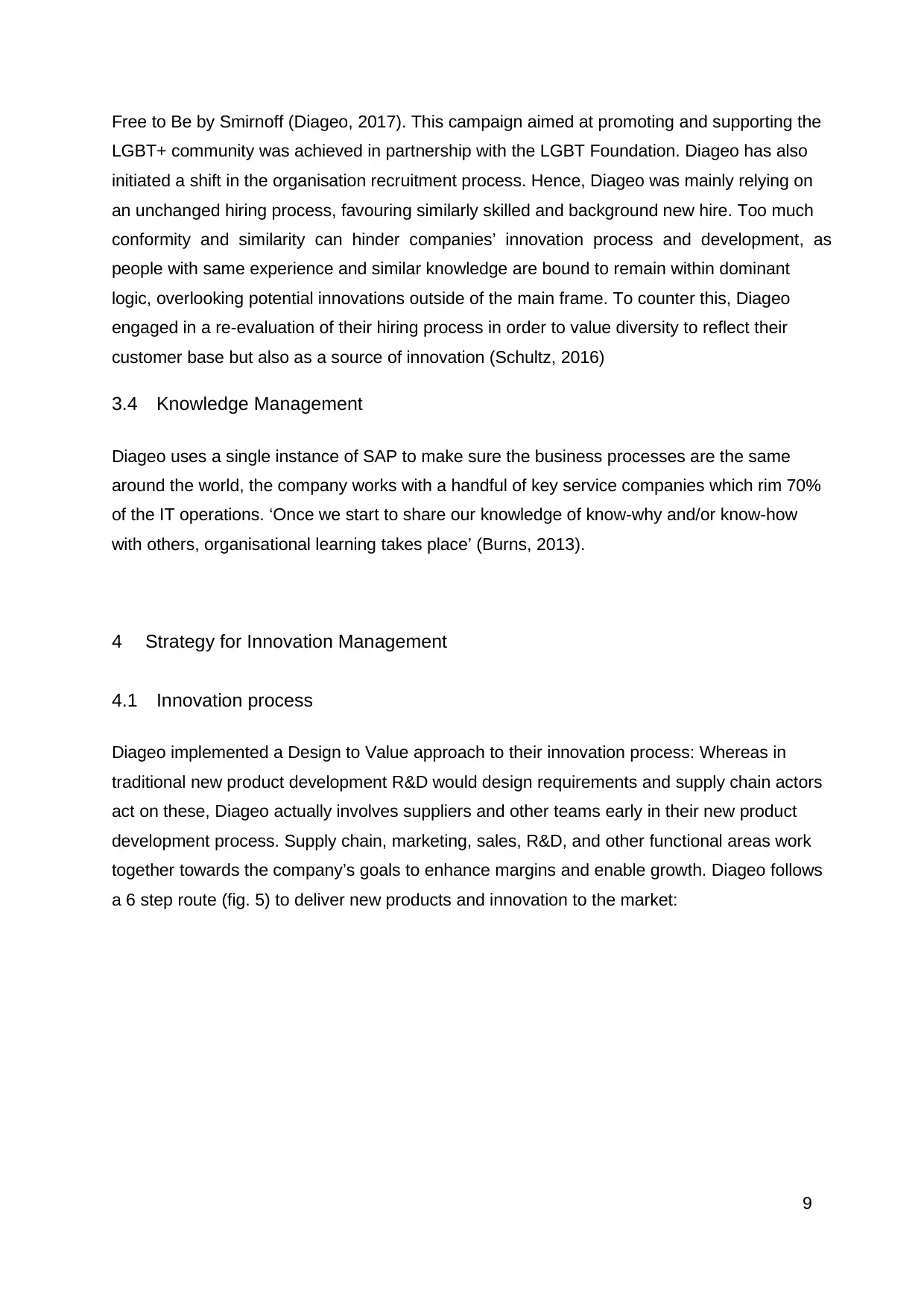
9
Free to Be by Smirnoff (Diageo, 2017). This campaign aimed at promoting and supporting the
LGBT+ community was achieved in partnership with the LGBT Foundation. Diageo has also
initiated a shift in the organisation recruitment process. Hence, Diageo was mainly relying on
an unchanged hiring process, favouring similarly skilled and background new hire. Too much
conformity and similarity can hinder companies’ innovation process and development, as
people with same experience and similar knowledge are bound to remain within dominant
logic, overlooking potential innovations outside of the main frame. To counter this, Diageo
engaged in a re-evaluation of their hiring process in order to value diversity to reflect their
customer base but also as a source of innovation (Schultz, 2016)
3.4 Knowledge Management
Diageo uses a single instance of SAP to make sure the business processes are the same
around the world, the company works with a handful of key service companies which rim 70%
of the IT operations. ‘Once we start to share our knowledge of know-why and/or know-how
with others, organisational learning takes place’ (Burns, 2013).
4 Strategy for Innovation Management
4.1 Innovation process
Diageo implemented a Design to Value approach to their innovation process: Whereas in
traditional new product development R&D would design requirements and supply chain actors
act on these, Diageo actually involves suppliers and other teams early in their new product
development process. Supply chain, marketing, sales, R&D, and other functional areas work
together towards the company’s goals to enhance margins and enable growth. Diageo follows
a 6 step route (fig. 5) to deliver new products and innovation to the market:
Free to Be by Smirnoff (Diageo, 2017). This campaign aimed at promoting and supporting the
LGBT+ community was achieved in partnership with the LGBT Foundation. Diageo has also
initiated a shift in the organisation recruitment process. Hence, Diageo was mainly relying on
an unchanged hiring process, favouring similarly skilled and background new hire. Too much
conformity and similarity can hinder companies’ innovation process and development, as
people with same experience and similar knowledge are bound to remain within dominant
logic, overlooking potential innovations outside of the main frame. To counter this, Diageo
engaged in a re-evaluation of their hiring process in order to value diversity to reflect their
customer base but also as a source of innovation (Schultz, 2016)
3.4 Knowledge Management
Diageo uses a single instance of SAP to make sure the business processes are the same
around the world, the company works with a handful of key service companies which rim 70%
of the IT operations. ‘Once we start to share our knowledge of know-why and/or know-how
with others, organisational learning takes place’ (Burns, 2013).
4 Strategy for Innovation Management
4.1 Innovation process
Diageo implemented a Design to Value approach to their innovation process: Whereas in
traditional new product development R&D would design requirements and supply chain actors
act on these, Diageo actually involves suppliers and other teams early in their new product
development process. Supply chain, marketing, sales, R&D, and other functional areas work
together towards the company’s goals to enhance margins and enable growth. Diageo follows
a 6 step route (fig. 5) to deliver new products and innovation to the market:
⊘ This is a preview!⊘
Do you want full access?
Subscribe today to unlock all pages.

Trusted by 1+ million students worldwide

10
Figure 5 - Diageo Design to Value Process
This approach to design to Value allows Diageo team members to not only focus on cost
cutting reduction but rather to design for the product that will generate the highest margin
whilst still delivering value to the customer.
4.2 Search Strategies
To be able to source radical and incremental innovations, Diageo has put in place multiple
search strategies to be able to exploit and explore its external environment.
Figure 5 - Diageo Design to Value Process
This approach to design to Value allows Diageo team members to not only focus on cost
cutting reduction but rather to design for the product that will generate the highest margin
whilst still delivering value to the customer.
4.2 Search Strategies
To be able to source radical and incremental innovations, Diageo has put in place multiple
search strategies to be able to exploit and explore its external environment.
Paraphrase This Document
Need a fresh take? Get an instant paraphrase of this document with our AI Paraphraser
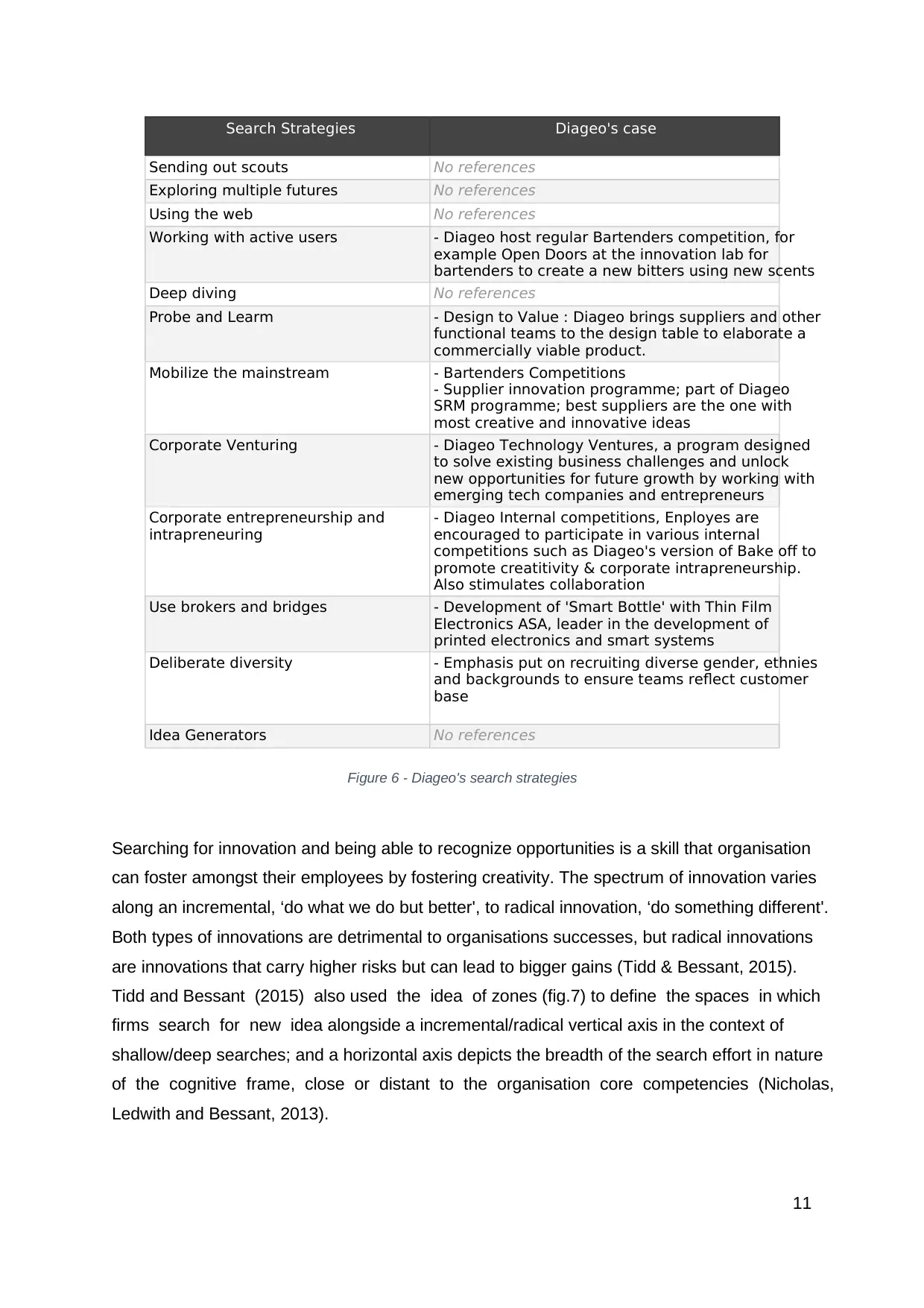
11
Figure 6 - Diageo's search strategies
Searching for innovation and being able to recognize opportunities is a skill that organisation
can foster amongst their employees by fostering creativity. The spectrum of innovation varies
along an incremental, ‘do what we do but better', to radical innovation, ‘do something different'.
Both types of innovations are detrimental to organisations successes, but radical innovations
are innovations that carry higher risks but can lead to bigger gains (Tidd & Bessant, 2015).
Tidd and Bessant (2015) also used the idea of zones (fig.7) to define the spaces in which
firms search for new idea alongside a incremental/radical vertical axis in the context of
shallow/deep searches; and a horizontal axis depicts the breadth of the search effort in nature
of the cognitive frame, close or distant to the organisation core competencies (Nicholas,
Ledwith and Bessant, 2013).
Search Strategies Diageo's case
Sending out scouts No references
Exploring multiple futures No references
Using the web No references
Working with active users - Diageo host regular Bartenders competition, for
example Open Doors at the innovation lab for
bartenders to create a new bitters using new scents
Deep diving No references
Probe and Learm - Design to Value : Diageo brings suppliers and other
functional teams to the design table to elaborate a
commercially viable product.
Mobilize the mainstream - Bartenders Competitions
- Supplier innovation programme; part of Diageo
SRM programme; best suppliers are the one with
most creative and innovative ideas
Corporate Venturing - Diageo Technology Ventures, a program designed
to solve existing business challenges and unlock
new opportunities for future growth by working with
emerging tech companies and entrepreneurs
Corporate entrepreneurship and
intrapreneuring
- Diageo Internal competitions, Enployes are
encouraged to participate in various internal
competitions such as Diageo's version of Bake off to
promote creatitivity & corporate intrapreneurship.
Also stimulates collaboration
Use brokers and bridges - Development of 'Smart Bottle' with Thin Film
Electronics ASA, leader in the development of
printed electronics and smart systems
Deliberate diversity - Emphasis put on recruiting diverse gender, ethnies
and backgrounds to ensure teams reflect customer
base
Idea Generators No references
Figure 6 - Diageo's search strategies
Searching for innovation and being able to recognize opportunities is a skill that organisation
can foster amongst their employees by fostering creativity. The spectrum of innovation varies
along an incremental, ‘do what we do but better', to radical innovation, ‘do something different'.
Both types of innovations are detrimental to organisations successes, but radical innovations
are innovations that carry higher risks but can lead to bigger gains (Tidd & Bessant, 2015).
Tidd and Bessant (2015) also used the idea of zones (fig.7) to define the spaces in which
firms search for new idea alongside a incremental/radical vertical axis in the context of
shallow/deep searches; and a horizontal axis depicts the breadth of the search effort in nature
of the cognitive frame, close or distant to the organisation core competencies (Nicholas,
Ledwith and Bessant, 2013).
Search Strategies Diageo's case
Sending out scouts No references
Exploring multiple futures No references
Using the web No references
Working with active users - Diageo host regular Bartenders competition, for
example Open Doors at the innovation lab for
bartenders to create a new bitters using new scents
Deep diving No references
Probe and Learm - Design to Value : Diageo brings suppliers and other
functional teams to the design table to elaborate a
commercially viable product.
Mobilize the mainstream - Bartenders Competitions
- Supplier innovation programme; part of Diageo
SRM programme; best suppliers are the one with
most creative and innovative ideas
Corporate Venturing - Diageo Technology Ventures, a program designed
to solve existing business challenges and unlock
new opportunities for future growth by working with
emerging tech companies and entrepreneurs
Corporate entrepreneurship and
intrapreneuring
- Diageo Internal competitions, Enployes are
encouraged to participate in various internal
competitions such as Diageo's version of Bake off to
promote creatitivity & corporate intrapreneurship.
Also stimulates collaboration
Use brokers and bridges - Development of 'Smart Bottle' with Thin Film
Electronics ASA, leader in the development of
printed electronics and smart systems
Deliberate diversity - Emphasis put on recruiting diverse gender, ethnies
and backgrounds to ensure teams reflect customer
base
Idea Generators No references

12
Figure 7 - Innovation search space (Nicholas, Ledwith and Bessant, 2013)
From figure 6, Diageo mostly engage in search strategies within the exploitative zone,
sourcing for incremental innovation within the existing frame (low-risk innovations). However,
Diageo venturing has potential for co-evolving with radical innovation in new frames
4.3 Diageo Supply Chain
In recent years Diageo initiated a number of change within the organisation in order to drive
innovation. This global transformation of the company allowed them to release about 250 new
product innovations in 2015 which accounted for over £500 million in sales a year. At the heart
of the company's innovation is the end-to-end transformation initiated which saw a shift in
cultural mindset around supply chain management and design to value approach to innovation
(Trebilcock, 2015).
In order to maximise potential revenues and increasing productivity, Diageo invested $250
millions in plants and IT infrastructure to support a differentiated supply chain and
standardizing on SAP’s APO SmartOps for inventory planning by SKU (Trebilcock, 2015).
Diageo broad portfolio of products can actually be a challenge in term of producing as products
have different requirements with some having no selling forecast. By redesigning in their
supply chain allows Diageo to operate highly-automated lines for high volume brands such as
Smirnoff and innovation lines for smaller production such as small batch of aged whiskies or
temporary promotions. These dedicated lines offer flexibility, faster reaction time and less
need for stock for Diageo.
Diageo also implemented differentiated Sales & Operations (S&OP) for its innovation,
in order to respond to market volatility. Innovation S&OP at Diageo regularly involves and
Figure 7 - Innovation search space (Nicholas, Ledwith and Bessant, 2013)
From figure 6, Diageo mostly engage in search strategies within the exploitative zone,
sourcing for incremental innovation within the existing frame (low-risk innovations). However,
Diageo venturing has potential for co-evolving with radical innovation in new frames
4.3 Diageo Supply Chain
In recent years Diageo initiated a number of change within the organisation in order to drive
innovation. This global transformation of the company allowed them to release about 250 new
product innovations in 2015 which accounted for over £500 million in sales a year. At the heart
of the company's innovation is the end-to-end transformation initiated which saw a shift in
cultural mindset around supply chain management and design to value approach to innovation
(Trebilcock, 2015).
In order to maximise potential revenues and increasing productivity, Diageo invested $250
millions in plants and IT infrastructure to support a differentiated supply chain and
standardizing on SAP’s APO SmartOps for inventory planning by SKU (Trebilcock, 2015).
Diageo broad portfolio of products can actually be a challenge in term of producing as products
have different requirements with some having no selling forecast. By redesigning in their
supply chain allows Diageo to operate highly-automated lines for high volume brands such as
Smirnoff and innovation lines for smaller production such as small batch of aged whiskies or
temporary promotions. These dedicated lines offer flexibility, faster reaction time and less
need for stock for Diageo.
Diageo also implemented differentiated Sales & Operations (S&OP) for its innovation,
in order to respond to market volatility. Innovation S&OP at Diageo regularly involves and
⊘ This is a preview!⊘
Do you want full access?
Subscribe today to unlock all pages.

Trusted by 1+ million students worldwide
1 out of 19
Related Documents
Your All-in-One AI-Powered Toolkit for Academic Success.
+13062052269
info@desklib.com
Available 24*7 on WhatsApp / Email
![[object Object]](/_next/static/media/star-bottom.7253800d.svg)
Unlock your academic potential
Copyright © 2020–2025 A2Z Services. All Rights Reserved. Developed and managed by ZUCOL.





